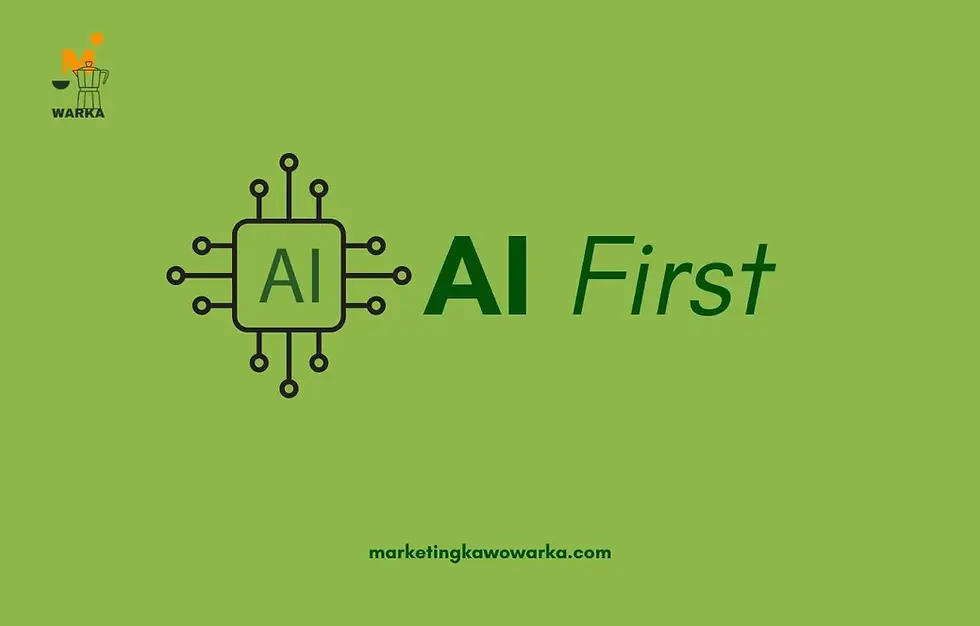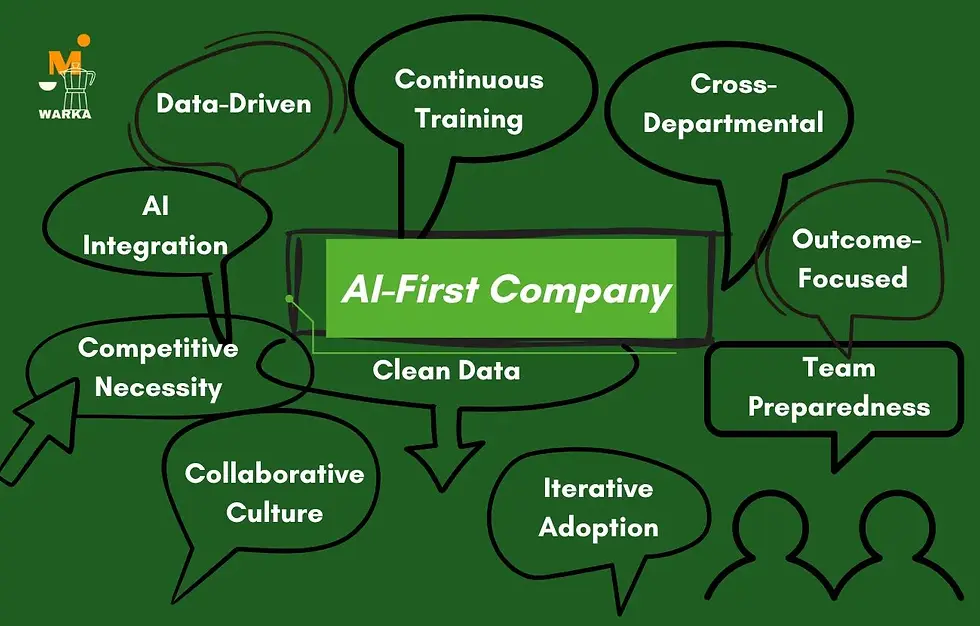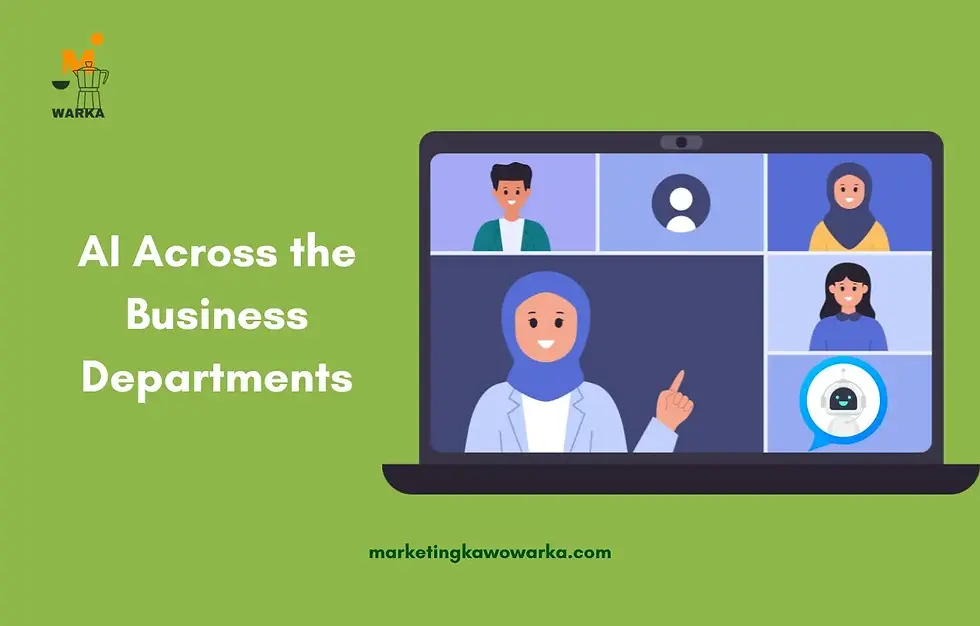How Companies Is Moving to Be an AI-First Company
- Olha Berezhna

- Aug 5
- 9 min read
Let's be honest from the beginning: if you're a C-level executive or directly involved, have you already started referring to your company as AI-oriented? Does it mean, in fact, that you paid for the paid version of Chat GPT? We are going to have a serious discussion and sort everything out.

What Does It Mean to Be the Best AI Software Company?
It is a well-established integrated AI in every company's business process, from small tasks of data collection to involving AI in the process of working on specific projects.
AI-first company is supporting decisions with data, analytical results, but not just with intuition.
It is continuous training of your AI assistants, which is a sort of education of your AI department, and improving it permanently.
In an ideal world, it is necessary to start restructuring business processes via each checklist (and at the same time remind yourself whether it all works as you intended). In practice, many businesses incorporate AI components into their processes and expect results that exceed expectations.
Let's determine how realistic the first and second options are and in which business processes of your startup or growing enterprise AI restructuring will yield the best results.
Why Companies Are Moving Toward AI‑First Operating Models
In 2025, many companies want to be AI technology companies and have become participants in a survival business game. Permanent offers of AI solutions only aggravate this game. The demand for AI solutions is unstable, and the number of offers is growing every year. The question arises: is AI business transformation a tribute to fashion and a desire to run in a competitive race, or is it still a necessity?

The problem of competition
This is one of the driving forces of progress and the red start button for the development of companies. But let's not ignore the fact that there are companies that make a thousand optimized decisions per second based on the analysis of market data focused on artificial intelligence (for example, Netflix with their recommendation systems). At the same time, some companies are still trying to understand what the audience wants, focusing solely on the ratings from the last quarter.
Economic profitability
Let's go through the numbers: a traditional customer support service can handle approximately 50-60 calls per operator per day. In turn, the AI assistant can simultaneously process from 10,000 to 50,000 simultaneous chat interactions without additional motivation.
Market pressure points
Here, three critical points come together: customers expect personalized service, investors demand increased efficiency, and the team wants to work with popular and effective tech solutions.
The idea is obvious: switching to AI-oriented business processes in a company is not a way to stay ahead; currently, it is already a way to survive in the market race.
AI Across the Business: Key Departments Driving the Shift
Choosing the right department to integrate AI workflows isn’t a one-size-fits-all decision. There is a time-tested system for evaluating the improvement of current processes. But let's look at how the implementation of AI tools can affect each department of your company so that you can choose the direction of the AI lever.
Selection of Candidates With Frightening Accuracy
What is the first step in the process of AI? A highly profitable company is about people and the ability to build an expert team. If you see gaps in this process, then it makes sense to delve deeper into this area. AI tools for the recruiting process allow you to analyze a profile for compliance with the stated criteria, experience, soft, and hard skills. For example, your AI assistant Findem will do an excellent job of sourcing and initial screening of a candidate, and Plum will help evaluate a candidate for compliance with the corporate culture, personal qualities, and skills.
One of the most far-sighted and interesting is the predictive function of AI assistants. Analyzing employee sentiment and engagement levels can signal potential layoffs. ML and explainable AI models have demonstrated high accuracy (up to 92–93%) in identifying employees who are likely to leave based on factors such as satisfaction and engagement.
Thus, the implementation of AI for HR processes can generally stabilize personnel management processes.

Marketing and Customer Interaction
The implementation of AI in marketing directly improves ROI and enhances customer loyalty; therefore, the development of AI assistants in this area should be monitored with particular precision.
Today, the following areas of AI in marketing are typically highlighted, which can increase the company's revenue:
Hyperpersonalization
Your AI assistant can analyze large volumes of data and offer recommendations based on their results. For example, personalized recommendations of goods and services via email increase the chances of making a re-order.
Customer interaction management
Chat with clients goes beyond a simple "write to us" or "fill out the contact form". The AI assistant analyzes the request of your lead/client, compares it with its knowledge base, and provides results in the form of step-by-step instructions. I highly recommend reviewing the PipeDrive chatbot, which empathizes with your problem together with you.
Another interesting point is that the AI assistant in marketing is a certain brand radar that helps to assess user sentiment and predict the results of specific marketing campaigns.
Content creation and optimization
The AI assistant in marketing helps reuse your content several times and targets your audience in different channels. This is an accelerated omnichannel approach. Therefore, if you are determined to transfer the content optimization process to AI tracks, try the HubSpot video maker that generates video from your text.
Also, no less critical is SEO optimization of content using AI tools, for example, to determine the strengths and weaknesses of content, as well as places for improvement, and to identify irrelevant data. For this, by the way, ChatGPT is perfect, but you will have to run it several times on your personal tasks.
Lead Scoring Without a Fortune Teller
How many times have you heard the classic test for sales managers: 'Sell me this pen'?" Several years ago, it was considered a standard question that showed how well your sales manager could persuade and sell "ice to penguins."
Nowadays, in the business community, there is no clear answer about whether it is necessary to sell a pen to someone who does not need it, but one thing is clear: selling a pen to someone who does need it is much easier and faster. AI tools take on the assessment and scoring of leads perfectly.
A great example is Salesforce Einstein, the key areas of which are:
Predictive lead scoring: using machine learning, the AI assistant analyzes historical data and reveals conversion patterns.
Lead qualification: allows you to get detailed information about the company, including position, company size, and social media presence.
If this story resonates with you, consider implementing an AI assistant in your sales department.
Financial Operations
Well, admit it — you’ve always wanted to work with the kind of forecast accuracy you see in The Day After Tomorrow, right? AI forecasts cash flows with fantastic accuracy and can quickly identify fraudulent transactions. If you think that an AI assistant in finance is only about forecasts, then read the latest case about how AI is plugging the £112 billion cash-flow leak.
AI financial assistants help reduce the amount of manual work, increase accuracy, and make faster and more informed decisions.
Top 3 popular AI financial assistants:
An Excel-integrated AI assistant that extracts, matches, and verifies source documents, minimizing manual labor
An AI assistant for monitoring current financial activities, analyzing transactions, and detecting fraud.
An AI assistant for analyzing expenses and budget compliance in real time.
If your goal is to reduce the amount of manual work in your finance department, an AI assistant is a hero who does not wear a red cape, but is always ready to help.
IT Security and Cybersecurity
Threats are becoming more intelligent and dangerous, but the methods for detecting and mitigating them are also evolving. AI assistants are actively used to detect, analyze, and respond to threats in real time.
AI assistants can analyze large amounts of data to identify threats and respond with minimal impact on your business.
AI cyber-assistants assess the risks associated with the vulnerability of your systems; they can also prioritize their elimination, as well as automate workflows for their mitigation, remediation, and reporting on compliance.
If your IT department needs automation and help prioritizing tasks to reduce the workload of installing patches, consider the following AI assistants in cybersecurity.
It will allow you to speed up threat detection by analyzing similar threats. The AI-assistant will facilitate automatic action transfers based on historical patterns of analyzed activity and the level of confidence.
This AI assistant will help you determine how vulnerable you are to the latest threats, which key cybersecurity risks to cover first, and assess your cybersecurity posture to make more informed decisions.
Real-World Examples of AI in Action
Many companies are moving beyond using AI in a single department or product. Instead, they are integrating AI across their entire organization to improve efficiency, transform their operations, and stay ahead of the competition.
For example, for the giant Amazon, which can be called the top AI company in the world, integrating AI assistants into business processes has become a key driver of business process development.
The AI assistant allows them to forecast demand for millions of products and manage inventory placement. This process covers the entire supply chain, from procurement to warehouse management.
The AI assistant is tailored for Amazon to optimize delivery processes and routes for the entire fleet of vehicles. Thanks to the support, the traffic situation, weather conditions are taken into account and the most economical routes are selected.
And the financial leader JPMorgan Chase is implementing AI assistants to detect fraud and identify risks by analyzing millions of transactions in real time. This is good support for the company in terms of protecting customers and minimizing financial losses.
JPMorgan Chase has streamlined the process of analyzing and extracting critical information from thousands of commercial loan agreements in seconds with the help of an AI assistant. Now, a task that took hours of manual work is automated.
The AI assistant helps JPMorgan Chase advisors analyze market data and client profiles, offering customized investment strategies.

Common Missteps in Becoming AI-First and How to Avoid Them
Transitioning a company to AI rails is like learning to drive: you think that everything is simple and you should stick to an elementary algorithm to make everything work, until you find yourself in the oncoming lane without understanding how it happened and what the solution is.
Let's look at several vital points that you should pay attention to when connecting AI assistants to maximize the success of AI operations.
Lack of communication between departments
Implementing AI assistants in different departments can bring excellent business results, but this is where the experiment stops and does not move forward.
What is the mistake? Lack of transparency and interaction between departments. Therefore, during the AI-pilot tests, each of the experts relies only on their results, and not on the overall transformation. The company focuses on the fact that the pilot project was unsuccessful and does not push the implementation further.
Lack of data organization
AI assistants need clean and correct data to work correctly, but in many companies, the data is scattered or even collected incorrectly. Imagine a situation where data on the same lead may differ in the CRM, billing system, and, for example, the email marketing database. The AI assistant tries to analyze the lead's data, but is faced with a misunderstanding about whether this is one person, what their age, location, company, etc are.
The Change Management "Black Hole"
People in a company are the main resource. However, with the emergence of a large number of AI tools, company management began to forget that the team needs to be prepared for such changes. Thus, the company implements a high-cost AI tool, for example, in the finance department, and the financial director, Sarah, refuses to use this tool, because:
- does not fully understand how it works;
- thinks that the AI assistant will replace her;
- does not see the effectiveness of it.
Without an approach to change management in the team, even the most advanced AI assistant becomes useless.
The "set it up and forget it" syndrome
One of the most common mistakes companies make when trying to implement AI in business processes is the vision that they should simply integrate the technology and it will magically solve all their problems.
The time for reporting comes, and resistance and contradictions between promises and reality arise.
Based on all of the above, remember that AI primacy is not a goal, but a solution that should be superimposed on existing problems and legacy systems. AI agents are a fundamental jet engine, but they will only work with the right fuel.
Conclusion
Let's be honest, the path to being AI-first in business is complex and bumpy. Many companies realize along the way that they are not ready for this and put the process on pause.
The winners of this race will not be the companies with the biggest budgets or the most complex integration of AI agents into business processes, but those who can combine human creativity with AI agents, creating a hybrid force that is smarter, faster, and will bring maximum benefits to business.
.png)

